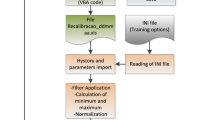Abstract
In general, industrial processes have a multivariable nature, with multiple inputs and multiple outputs. Such systems are more difficult to monitor and control due to interactions between the input and output variables. Focusing on these issues, the development of soft sensors to monitor multivariate nonlinear processes using neural networks is proposed. Experiments were performed to monitor the pressure and flow values on an experimental platform (fluid transport system) using developed soft sensors. With the monitoring using soft sensor, it is possible to make processes more reliable, with better performance and with less difficulty in detecting and solving possible failures.









Similar content being viewed by others
References
Anthony, E. J., Talbot, R. E., Jia, L., & Granatstein, D. L. (2000). Agglomeration and fouling in three industrial petroleum coke- red cfbc boilers due to carbonation and sulfation. Energy & Fuels, 14, 1021–1027.
Arsie, I., Cricchio, A., Cesare, M. D., Lazzarini, F., Pianese, C., & Sorrentino, M. (2017). Neural net-work models for virtual sensing of NOx emissions in automotive diesel engines with least square-based adaptation. Control Engineering Practice, 61, 11–20.
Buondonno, G. & Luca, A. D. (2016), Combining real and virtual sensors for measuring interaction forces and moments acting on a robot. In International conference on intelligent robots and systems (IROS).
Corriou, J.-P. (2018). Process control: Theory and applications (2nd ed.). Cham: Springer.
Cybenko, G. (1989). Approximation by superpositions of a sigmoid function. Mathematics of Control, Signals, and Systems, 2(4), 303–314.
Ell, S. M., & Trabachini, A. (2011). Loss of charge in forced conduits. Retrieved January 18, 2018 from http://pt.scribd.com/doc/72710149/Perda-de-Carga-Tubulacao-Singular-Ida-Des.
Engelbrecht, A. P. (2007). Computational intelligence—An introduction (2nd ed.). Pretoria: Wiley, University of Pretoria South Africa.
Fortuna, L., Graziani, S., & Xibilia, M. G. (2007). Soft sensor for monitoring and control of industrial processes. London: Editora Springer.
Fox, R. W., McDonald, A. T., & Pritchard, P. J. (2017). Introduction to Fluid Mechanics, 8 edn. India: Wiley.
Haykin, S. (2009). Neural networks and learning machines (3rd ed.). Ontario: Prentice Hall.
Joseph, B., & Brosilow, C. (1978). Inferential control of processes: Part i, ii e iii. American Institute of Chemical Engineers (AIChE Journal), 24, 485–509.
Kadlec, P., Gabrys, B., & Strandt, S. (2008). Data-driven soft sensors in the process industry. Computers & Chemical Engineering, 33, 795–814.
Kah, P., Layus, P., Hiltunen, E., & Martikainen, J. (2014). Real-time weld process monitoring. Advanced Materials Research, 933, 117–124.
Liu, L., Chen, J. & Xu, L. (2008). Realization and application research of BP neural network based on MATLAB. In International seminar on future biomedical information engineering.
Lopes, A. M., Lapa, J. P. & Oliveira, L. A. (2006). Turbulent laminar regime transition unit—practical workbook. Retrieved January 18, 2018 from https://woc.uc.pt/dem/getFile.do?tipo=6&id=362.
Mansano, R. K., Godoy, E. P., & Porto, A. J. V. (2014). The bene ts of soft sensor and multi-rate control for the implementation of wireless networked control systems. Sensors, 14, 24441–24461.
Mansoori, G. (2001), Deposition and fouling of heavy organic oils and other compounds. In 9th International conference on properties an phases equilibria for product and process design.
Markopoulos, A. P., Georgiopoulos, S., & Manolakos, D. E. (2016). On the use of back propagation and ra-dial basis function neural networks in surface rough-ness prediction’. Journal of Industrial Engineering International, 12, 389–400.
Marques, J. A. A. S. & Sousa, J. J. O. (1997). Formula of colebrook—white: old but current. explicit solutions. In 3rd Symposium on hydraulics and water re-sources in Portuguese-speaking Countries (Silusba).
Melo, T. R., Bezerra, M. M., da Silva, J. J., & da Rocha Neto, J. S. (2017). Implementation of a decentralized pid control system on an experimental platform using labview. Latin America Transactions, 15, 213–218.
Ortega, E. (2012). Calculation of the friction energy. http://www.unicamp.br/fea/ortega/aulas/aula05\_fator\_atrito.ppt.
Palcios, R. H. C., da Silva, I. N., Goedtel, A., Godoy, W. F., & Oleskovicz, M. (2014). A robust neural method to estimate torque in three-phase induction motor. Journal of Control, Automation and Electrical Systems, 25, 493–502.
Samarasinghe, S. (2006). Neural Networks for Applied Sciences and Engineering. Boca Raton: Auerbach Publications.
Saptoro, A. (2014). State of the art in the develop-ment of adaptive soft sensors based on just-in-time models’. International Conference and Workshop on Chemical Engineering, 9, 226–234.
Severson, K., Chaiwatanodom, P., & Braatz, R. D. (2015). Perspectives on process monitoring of industrial systems’. International Federation of Automatic Control (IFAC), 48, 931–939.
Tiwari, S. K., & Kaur, G. (2017). Model reduction by new clustering method and frequency response matching’. Journal of Control, Automation and Electrical Systems, 28, 78–85.
Wang, H., Oh, Y., & Yoon, E. S. (1998). Strategies for modeling and control of nonlinear chemical processes using neural networks’. Computers & Chemical Engineering, 22, 832–862.
Acknowledgements
The authors would like to thank CNPq and Copele-DEE for financial support.
Author information
Authors and Affiliations
Corresponding author
Rights and permissions
About this article
Cite this article
Monteiro, N.A.B., da Silva, J.J. & da Rocha Neto, J.S. Soft Sensors to Monitoring a Multivariate Nonlinear Process Using Neural Networks. J Control Autom Electr Syst 30, 54–62 (2019). https://doi.org/10.1007/s40313-018-00426-x
Received:
Revised:
Accepted:
Published:
Issue Date:
DOI: https://doi.org/10.1007/s40313-018-00426-x




